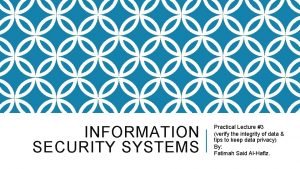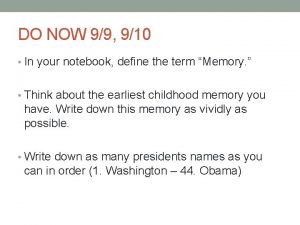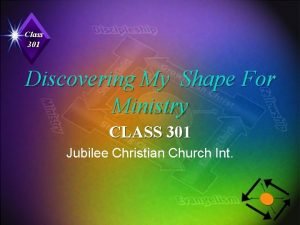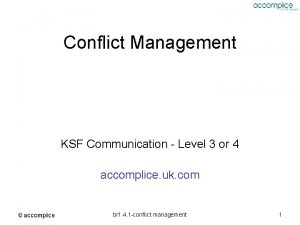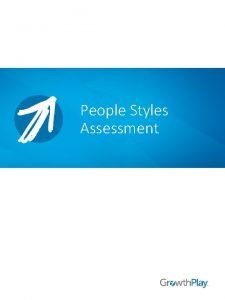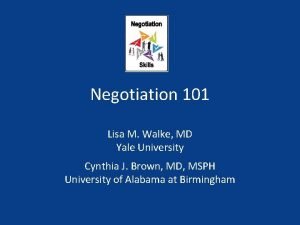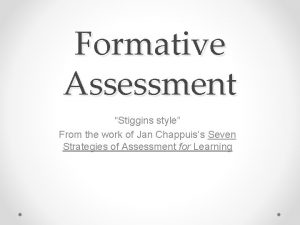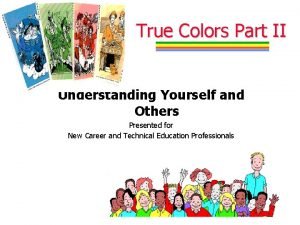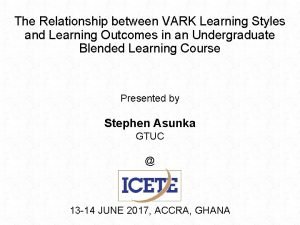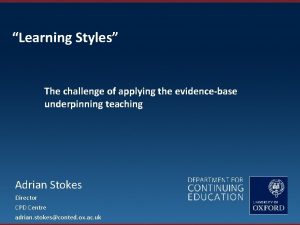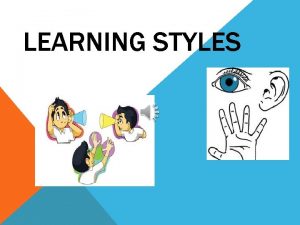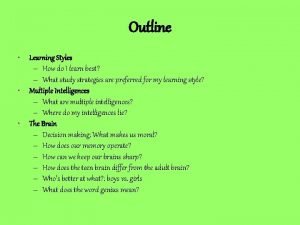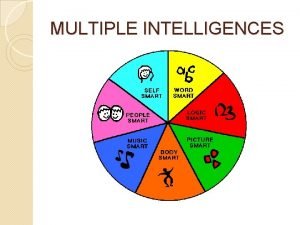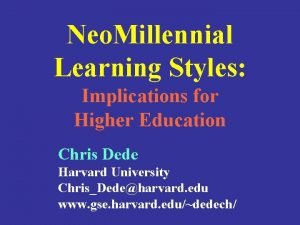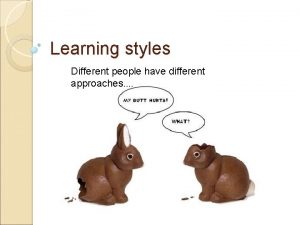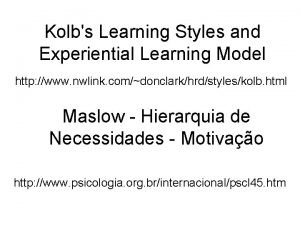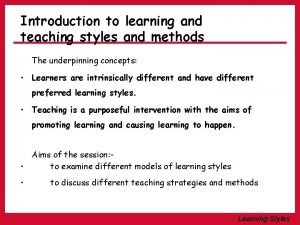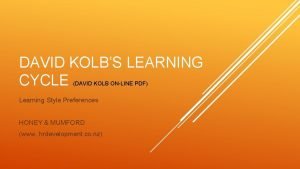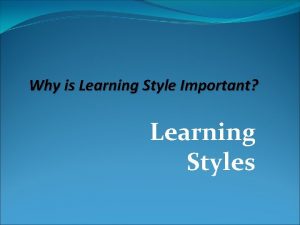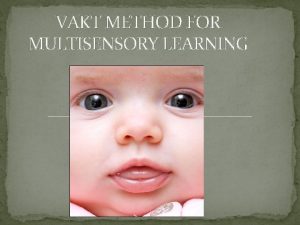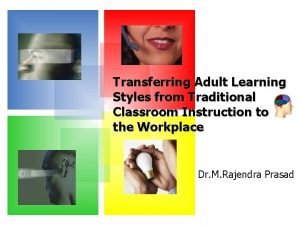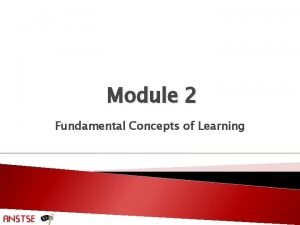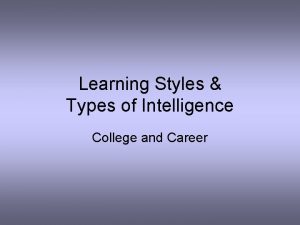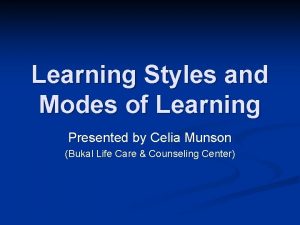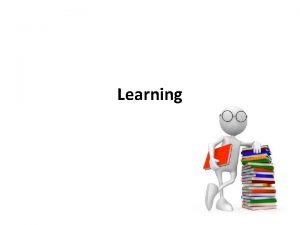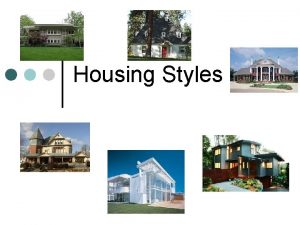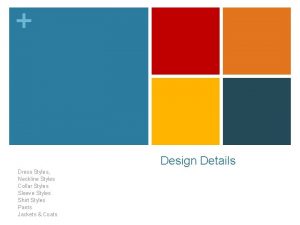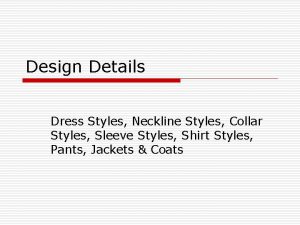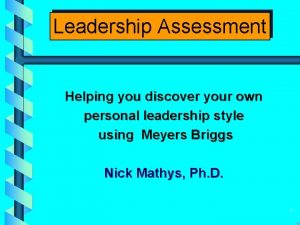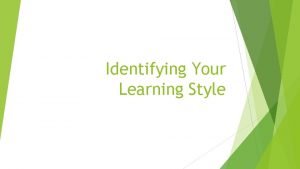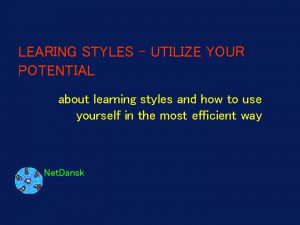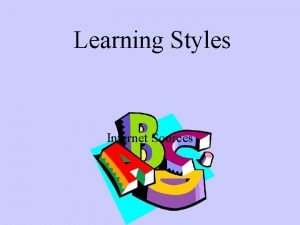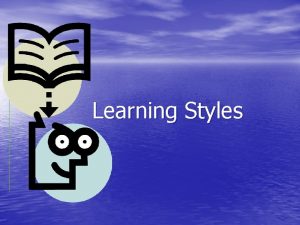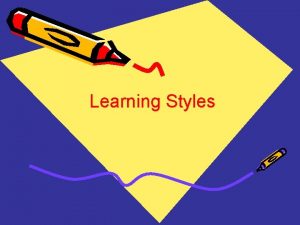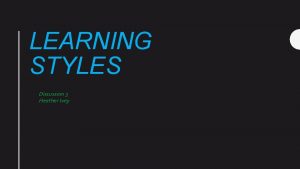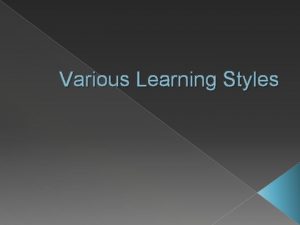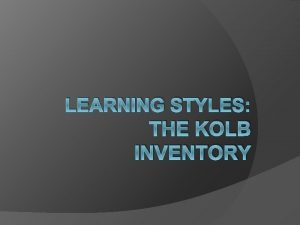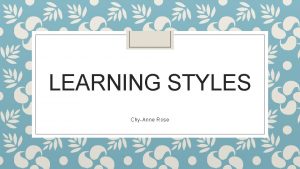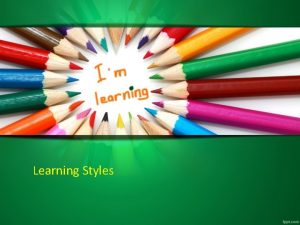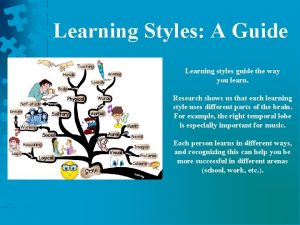Learning Styles Assessment Discover Your Own Learning Style

































- Slides: 33

Learning Styles Assessment Discover Your Own Learning Style and Using It to Study More Effectively

Your Learning Style Think about what you do when you have to learn something new. You probably approach each new learning situation in a similar way—you’ve developed a pattern for learning. This pattern is your learning style. When you become aware of your learning style, you understand when it can help you and when it can hinder you. If you can do that, you’ve got a head start on your education.

Please copy this answer key before you begin taking the test: Generalist/Detailer 1. 2. 3. 4. Total A’s ____ Total B’s ____ Left /Right Brain 5. 6. 7. 8. 9. Total A’s ____ Total B’s ____ Audio/Visual/Kinesthetic 10. 11. 12. 13 Total A’s ____ Total B’s ____ Total C’s ____ Five Ways Assessment 14. ____ 15. ____ 16. ____ 17. ____ 18. ____

On a piece of paper, answer the following questions. Generalist/Detailer 1. When I take notes in class, a. I concentrate mainly on general ideas. b. I concentrate mainly on details and facts. 2. When I review, a. I test myself by writing or reciting general summaries. b. I test myself by writing or reciting specific details.

3. When listening in class, I listen mainly for a. Important principles, theories, and ideas. b. important facts such as who, when, and where. 4. When I think about questions that might appear on a test, a. I emphasize main ideas. b. I emphasize specific facts. Write down the total number of "a" responses and total number of "b" responses.

Left/Right Brained 5. When reading a text that also presents the same information in a chart, diagram, or picture, do you a. concentrate on the written information? b. concentrate on the pictures, charts, and diagrams? 6. When taking a test, do you prefer a. multiple choice questions? b. open-ended questions? 7. Do you tend to remember people you have recently met by their a. names? b. faces?

8. Do you like your week to be a. carefully planned? b. unplanned and spontaneous? 9. Do you prefer classes in which you a. break a problem down, examine its parts in some kind of order, and then draw a conclusion? b. look at each problem as a whole and approach it by using hunches? Write down your total number of "a" responses and total number of "b" responses.

Audio/Visual/Kinesthetic 10. If someone were to give you directions to a new friend’s house, how would you prefer to get those directions? a. have someone take me there the first time, then find it later from memory. b. have someone draw me a map to follow. c. have someone tell me how to get there. 11. If you need to memorize a phone number, which of the following helps the most? a. dialing the number b. seeing the number c. hearing someone say the number

12. When you’re not sure how to spell a word, which would you do? a. write the word until it feels correct b. write the word until it looks correct c. sound out the word and write it as it sounds 13. The best way for me to learn in a class is a. through group projects and labs b. by having the professor diagram and show pictures, slides and videos of the information c. by listening to a lecture Write down your total number of "a" responses, "b" responses, and "c" responses.

Five Ways Assessment For each item, keep track of how many of the statements you answer "yes" to. 14. ____I prefer to think for myself rather than work with others. ____I prefer self-paced lessons from a text to lectures. ____I like to be given a general essay topic and then be allowed to narrow it to a specific topic. ____I do not like step-by-step deadline checks for portions of my papers to be completed. I prefer to be given a final deadline for the entire project.

15. ____I prefer lectures followed by discussions. ____I prefer to take notes while I am reading. ____I often think of examples from my own experiences that relate to the topics I am studying. ____I like to do extra reading and research about the topics I am studying.

16. ____I like to answer questions in class. ____I like to be a group leader in class. ____I like an instructor to acknowledge my participation in class. ____I like to get the highest grade in class.

17. ____I like to take classes on a no-credit basis rather than for a grade. ____I like it when the instructor provides a lecture outline. ____I prefer to listen and let the other students respond to questions. ____In group work, I prefer to let other students offer ideas.

18. ____I like to study with classmates outside of class. ____I prefer a class that includes group work and projects. ____I like to share my ideas with other students. ____I like doing group projects rather than individual projects. Count the number of "yes" answers for each block of the above questions and write down the totals.

Here’s what your scores mean: Generalist/Detailer If you answered more "a" than "b", you are a generalist If you answered more "b" than "a", you are a detailer

Left/Right Brained If you answered more "a" than "b", you are left-brained If you answered more "b" than "a", you are right-brained

Audio/Visual/Kinesthetic If you answered mostly "a" , you are a kinesthetic learner If you answered mostly "b", you are a visual learner If you answered mostly "c", you are an auditory learner (80% of the population are visual learners)

Five Ways Block 14: Mostly "yes"= independent learner Block 15: Mostly "yes"= discovery learner Block 16: Mostly "yes"= competitive learner Block 17: Mostly "yes"= dependent learner Block 18: Mostly "yes"= cooperative learner

Summary of Learning Preferences I approach studying mainly as a ____generalist ____detailer I tend to be ____left brain dominant ____right brain dominant ____balanced My learning style preference is ____audio ____visual ____kinesthetic Continued…

Rank your system preferences from 1 to 5, using 1 to indicate your main style and 5 as the style you use least. ____independent ____discovery ____dependent ____cooperative ____competitive Many people do not fall entirely into one category or another. If that is true for you, that’s fine. You have a combination of learning styles. The following descriptions of learning styles are to help any kind of combination learner understand themselves better.

Types of Learners 1. Generalist (Deductive Thinker) Characteristics Seeks overall view before moving into more detailed work. Organizes major ideas and concepts quickly. Strategies Use mapping or outline to begin study with overall picture. Use map or outline to guide you to details.

2. Detailer (Inductive Thinker) Characteristics: Moves from specifics to the general picture. Works with details and examples to draw conclusions. Examines minor points to seek main patterns. Strategies: Use note cards on which to record details. Place note cards into a map or outline to construct the overall picture.

LEFT- BRAINED Characteristics: Tends to be more punctual Likes structure Immediately starts a task Likes detailed instruction Is a perfectionist Learns through words Does only one thing at a time Uses logic over intuition Is a splitter or analyzer Strategies: Great at time management but need to work on being flexible. Ask for detailed instructions Allow yourself to be less than perfect

RIGHT-BRAINED Characteristics: Tends to have own concept of time Does not need order to learn Procrastinates Reads directions less Likes pictures & diagrams Likes to experiment Learns through visuals Does many things at once Uses intuitions over logic Is a grouper or synthesizer Strategies: Start early. Make a flexible time schedule with blocks of time set aside for tasks. (Use a "to do" list) Make a study schedule & use rewards to train yourself to use it. Make directions into diagrams or visuals. Recognize education style in us is mostly right-brained.

Visual/Kinesthetic/Auditory VISUAL One who learns best by looking at pictures, diagrams, and by reading. Strategies: Make pictures or maps out of what you are trying to learn. For example: in math, draw out word problems. Make greater use of pictures, charts, and diagrams in your textbooks. Ask your teacher or tutor for help in visualizing the material. Use analogies.

TACTILE / KINESTHETIC One who learns best by touching and doing things. Strategies: Do your homework as soon after class as possible. Take lab or hands-on classes as much as possible. Make flash cards from outlines or maps/matrixes. Write or move while studying. Make models of information being presented.

AUDITORY One who learns best by listening. Strategies: Attend and listen attentively in class. Recite aloud information as you work or study. Make rhymes or catchy phrases out of what you are learning. Put information on a tape with music and play it several times. Form study groups and share what you are trying to learn with others.

Five Ways Learning Styles Independent Learner (block 14) Characteristics Needs little direction. Self-Confident. Takes responsibility for own education and learning process. Strategies Be flexible. Know when to ask for help.

Discovery Learner (block 15) Characteristics Is curious. Goes beyond and in greater depth than what is expected. Strategies Make frequent checks on how much needs to be done.

Competitive Learner (block 16) Characteristics Wants to do well, be the best, and get the recognition. Works long hours. Strategies Adjust goals and priorities if overwhelmed.

Dependent Learner (block 17) Characteristics Wants instructor to provide instruction. Asks for help from others. Strategies Become more independent and active in learning.

Cooperative Learner (block 18) Characteristics Likes people and social interaction. Learns best by interacting with others. Strategies Work in study groups that are serious about study.

Thank you for taking this workshop. The LEC is designed to serve the students of Coconino Community College. We are eager to be a facilitator of successful learning! We invite you to visit our other web workshops.
 Lab – discover your own risky online behavior
Lab – discover your own risky online behavior Analytical sae examples
Analytical sae examples In your notebook describe the following
In your notebook describe the following Your conscious awareness of your own name and self identity
Your conscious awareness of your own name and self identity Smile tui
Smile tui Bill george true north
Bill george true north Discover your shape for ministry
Discover your shape for ministry Importance of knowing your learning style
Importance of knowing your learning style Teaching styles self-assessment tool
Teaching styles self-assessment tool Owl conflict style
Owl conflict style Shark teddy bear fox owl turtle
Shark teddy bear fox owl turtle Communication styles survey
Communication styles survey Yale university negotiation course
Yale university negotiation course Formative assessment in style
Formative assessment in style True colors learning styles
True colors learning styles Vark inventory
Vark inventory Education planner learning styles
Education planner learning styles Objectives of learning styles
Objectives of learning styles Learning style outline
Learning style outline Extracurricular activities
Extracurricular activities The seven learning styles
The seven learning styles Education styles
Education styles Objectives of learning styles
Objectives of learning styles 7 learning styles and vark similarities
7 learning styles and vark similarities Kolbs learning styles
Kolbs learning styles Driver expressive analytical amiable
Driver expressive analytical amiable Socioculturalism
Socioculturalism Kolbs theory
Kolbs theory Conclusion of learning styles
Conclusion of learning styles Vakt approach
Vakt approach Adult learning styles
Adult learning styles Different ways to learn
Different ways to learn Learning styles for career development
Learning styles for career development Education styles
Education styles
